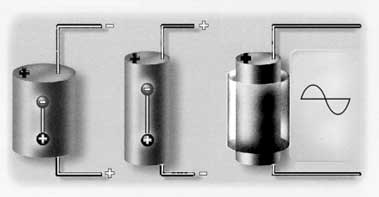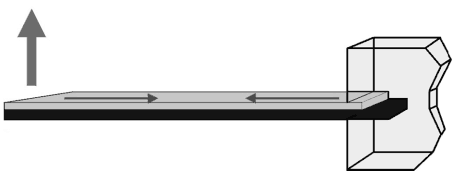3.4.2.8 Lead
zirconate titanate
Currently the most important piezoelectric
ceramic materials are based on mixed oxide crystal
system consisting of lead zirconate and lead titanate known
as lead zirconate titanate (PZT).
The specific properties of these ceramics,
such as the high dielectric constant, are dependent on the
molar ratio of lead zirconate to lead titanate as well as
on substitution and doping with additional elements. A wide
range of modifications can be implemented in this way, creating
materials with highly varied specifications.
The piezoelectric effect
The piezoelectric effect links both electrical
and mechanical properties.
Piezoelectricity refers to a linear electro-mechanical
interplay between the mechanical and electrical states of
a crystal.
The direct piezoelectric effect
refers to an electrical charge, detectable as a voltage, being
created in proportion to mechanical deformation of the crystal.

| Figure 21: |
Piezoelectric effect resulting from an external
force. The polarity of the electric charge depends on
the direction of the applied force. |
The reciprocal or inverse piezoelectric
effect refers to a deformation that arises in proportion to
an external electrical field created by the application of
an electrical voltage.

| Figure 22: |
he inverse piezoelectric effect under the
influence of external electric fields. The dimensions
of the body vary with the change in voltage. |
Principles
The piezoelectricity of ferroelectric materials is a consequence
of the existence of polar areas (domains) whose orientation
changes as result of the polarisation, i.e. of the application
of an electrical voltage. The polarisation is associated with
a change in length,  S. S.

Figure 23: Electric dipoles in a piezoelectric
material before and after polarisation.
Lead zirconium titanate Pb(Zrx Ti(1-x)) O3
is processed in polycrystalline form. The two most common
shaping methods are pressing and the tape casting process.
The green body acquires its ceramic properties through firing.
The piezoceramic, however, only acquires its technically interesting
piezoelectric properties through a polarisation process.

| Figure 24: |
Diagram of the domains in lead
zirconate titanate before, during and after polarisation
 S
= change in length during polarisation S
= change in length during polarisation
 Sr
= residual changing length after the polarisation process Sr
= residual changing length after the polarisation process |
Resonance modes in piezoelectric componen
All the components applied as sensors and actuators exploit
the fundamental vibration modes.

Figure 25: Fundamental vibration modes in
piezoceramic components
Structural forms
If the piezo-ceramic consists of one layer,
we speak of single layer technology. If the piezo-ceramic
component consists of a number of active piezo-ceramic layers,
we speak of multi-layer technology. Nowadays it is usual for
piezo-ceramic plates, strips, rings, domes, small tubes and
a large number of special geometries to be manufactured.
Their compact form means that piezo-ceramic
transducers take up little space, and use little energy when
used as actuators. Multi-layer actuators
are used when large movements are required that can also create
high forces.
The individual layers are connected electrically in parallel
so that the external voltage remains small.

Figure 26: Configuration and sectional diagram
of a monolithic multi-layer piezo-ceramic actuator.
Another variant is represented by the bending transducer.
This is created if, for instance, piezo-ceramic elements are
glued to a carrier material. The piezo-ceramic material reacts
with a change in its length when electrically stimulated.
The result, similar to that of a bimetal strip, is a large
change in the shape of the composite material, depending on
the voltage and its polarity, associated with moderate forces.

Figure 27: Application of the operating voltage
causes the piezo-ceramic to contract, causing the pair to
bend
Actuators with a passive layer and a piezo-ceramic component
are called monomorphic. A bimorphic bending transducer consists
of two piezo-ceramic elements without an intermediate passive
layer. A system consisting of two piezo-ceramic components
together with a passive intermediate layer is referred to
as trimorphic. A multimorphic bending transducer consists
of a large number of piezo-ceramic components, and does not
have passive intermediate layers.

Figure 28: Structural variants of piezo-ceramic
bending converters with
P = polarisation direction and E = direction of the electrical
field
Depending on the individual design of the bending transducer,
movements of several millimetres, forces of up to a few newtons,
and remarkably short movement times can be achieved. The bending
transducer can therefore be used as a powerful and rapidly
operating actuator.
Piezo-ceramics have won many applications
in electronics, in the motor vehicle industry, in medical
technology, in equipment and machine construction and consumer
applications:
piezo-ceramic components are used as transducers in telecommunications,
acoustics, hydro-acoustics, materials testing, ultrasonic
processing, liquid atomisation, flow measurement, level measurement,
distance measurement and medical technology. They are applied
as actuators in micro-pumps, in optical systems, gas valves,
low-pressure engineering, in inkjet printers, textile machines
and in Braille modules (reading devices for the blind). Applied
as sensors they react to force, pressure and acceleration,
making it possible to monitor a wide range of processes.
|

